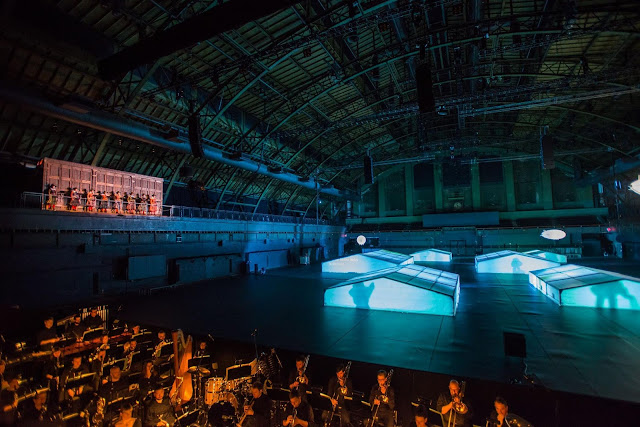We heard Louis Andreissen's "Die Materie", as staged by Heiner Goebbels in the Park Avenue Armory. "Die Materie" was written in the mid 1980's, and is a kind of symphony/oratorio/opera hybrid, originally conceived in collaboration with Robert Wilson. The subject, "matter" in English, is varied and complex, with texts ranging from the diaries of Marie Curie to ship building manuals. What Goebbels has done, however, is a kind of transformation of Andreissen's original musical conception into a spectacular event for arena-sized spaces, like the Park Avenue Armory. (It was originally commissioned for a very large space at a festival in Germany.) Which means, of course, that everything is amplified through loudspeakers. The famous introduction to the piece, when a very loud chord is repeated 144 times, was striking; you could hear the reverberation of the single chords echoing across the vast space. The amplification was superbly done, but, at the same time, I found myself wondering what the piece really sounded like. But the big excitement, though, and what the sellout crowds came for, was the spectacle of the staging. (It goes without saying that, had the NY Philharmonic put on a concert performance of the piece, no one would have come.) It was indeed an extraordinary spectacle, and an event I will never forget. The most spectacular part was the fourth moment, when Goebbels brought 100 live sheep into the arena, while illuminated zeppelins floated through the space above them. What it actually had to do with the music I have no idea, but the effect was extraordinary, especially once the sheep stopped humping each other and the audience giggles receded . The occasional "baa" blended in nicely with the music, and eventually the smell of the sheep wafted in our direction. It was fascinating to watch the both the predictability of the sheep movements (they do like to be a herd) and the actual unpredictability of individual movements, as individuals would sometimes detach themselves and start a sudden quick movement in a different direction. But ultimately, it was one of those image/music moments that resist easy explanation but somehow grip you.
Images from the web:
Another movement focused on Piet Mondrian, with a kind of Boogie-woogie music representing Mondrian's late infatuation with that music in New York. At a certain point, the orchestra, which had been in the middle of the audience sitting in the bleachers, began to slowly move on a platform to the center of the hall. It made for an interesting acoustic phenomenon, as the direct sound of the orchestra began to compete with the amplified sound from the speakers. And there were these extraordinary giant moving pendulums, gyrating constantly, all illuminated in Mondrian colors.
The opening scene appears with tents, illuminated from within; the tents presumably containing ship builders.
A choir of 17th century Dutch men (actually half of them were women)
And much, much more....
We were very lucky to have been able to see and hear this event. It was clear the the organizers were extremely well prepared, and obviously no expense was spared. (There were many articles in the media about the efforts involved in staging with 100 sheep, and the inevitable comparison with opera singers.) It also made me want to sit down and hear an actual performance of the music with a live orchestra in a concert hall.
We also heard a performance of Hans Abrahamsen's "Schee" (snow in German), done at Miller Theater's composer portrait series. I had greatly admired Abrahamsen's piece with Barbara Hannigan and the Cleveland orchestra in January, and was eager to hear another piece. It was for nine instruments: three strings, three winds, two pianos and percussion. The piece is about an hour long, and all of it is written in canons. As a whole, the piece was too minimal and spartan for my ears, at least at the moment of this concert. Though I can certainly imagine hearing it at another time when I might be more receptive. I also probably missed the voice of Barbra Hannigan; "Schnee" has much in common with the piece she sang in January, but the addition of a human voice to the music makes a great deal of difference.







